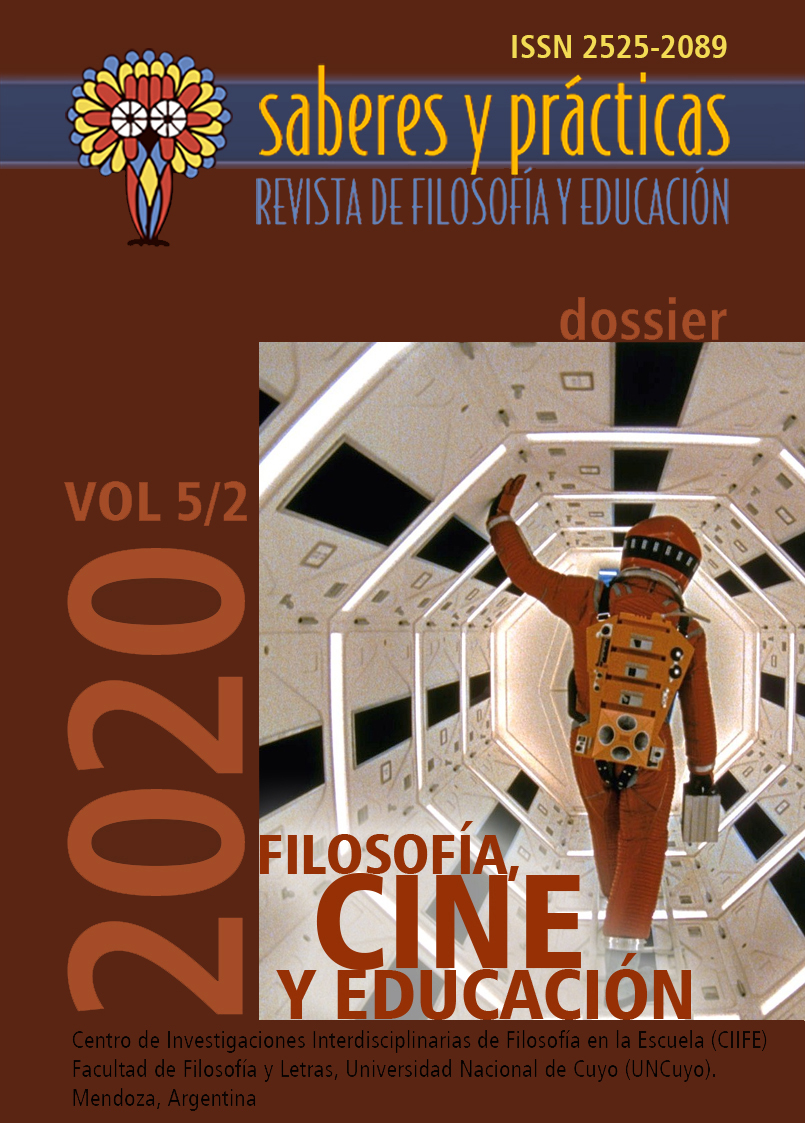Activating imaginaries from cinema
The educational power of images for the teacher training
Keywords:
Cinema, Education, Visual Culture, Representation, Teacher TrainingAbstract
This text explores the interlocution between filmic images, representation and teacher imaginary presented by Hollywood cinema from the educational perspective of visual culture. From experiences developed in different contexts of initial and permanent teacher training in Brazil, to develop pedagogical didactic strategies for the teacher training where films are powerful pedagogical devices. Teaching examined and articulated from the educational perspective of visual culture (Fernando Hernández, 2007, 2014) favors questioning the stereotypes to defining behaviors, outlining hierarchical positions and legitimizing social roles. Above all, the look produced by the dominant cinematography in our culture, which constitutes a strong reference for the construction and production of identities. The cinema understood as a cultural artifact subjected to the power of address from Elizabeth Ellsworth (2001, 2005), can become an object of challenge to stimulate critical and political thinking in teacher training. Instead, all films have their imagined audiences and are directed at "someone", in this case, films made with a very specific objective: to present us models of teaching that contemplate both imaginary collectives around the profession as it also aims to "inspire" future generations of teachers. Thinking about how these collective ways of seeing build ways of understanding the world prompts us to examine how the processes of subjectivation are configured from the relationships we establish between the image and the effects they produce on our own ways of being and acting.
Downloads
References
Bleckner, J. (Director) (2011) Detrás de la pizarra. (Beyond the blackboard). (Película)
Bolívar, A y Domingo; Fernández, M. (2001) La investigación biográfico-narrativa en educación: enfoque y metodología. La Muralla S. A.
Cuerda, J. L. (Director) (1999) La lengua de las mariposas. (Película)
Deleuze, G y Guattari, F. (1995) Mil Platôs. Capitalismo e Esquizofrenia. Vol. 1. Editora 34.
Duncum, P. (2011) Por que a arte-educação precisa mudar e o que podemos fazer. En Martins, Raimundo; Tourinho, Irene. (Eds.) Educação da cultura visual: conceitos e contextos. Ed. da UFSM. (p. 15-30).
Ellsworth, E. (2001). Modos de endereçamento: uma coisa de cinema; uma coisa de educação também. En Silva, T. T. da (Ed.). Nunca fomos humanos – nos rastros do sujeito. Autêntica.
Ellsworth, E. (2005) Posiciones en la enseñanza: diferencia, pedagogía y el poder de la direccionalidad. Akal.
Fleck, R. (Director) (2006). Half Nelson. (Película)
Freedman, K; Hernández, F. (1998) Curriculum, culture, and art education: comparatives perspectives. State University of New York.
Fresquet, A.(2013) Cinema e educação: reflexões e experiências com professores e estudantes de educação básica, dentro e ‘fora’ da escola. Autêntica.
Gansel, D. (Director) (2008) La Ola (Die Welle) (Película)
Gergen, K. (2007) Construccionismo social, aportes para el debate y la práctica. Universidad de los Andes, Ediciones Uniandes.
Giroux, H. A. (2003) Cine y entretenimiento: elementos para una crítica política del filme. Paidós.
Herek, S. (Director) (1995) Querido maestro (Mr. Holland’s Opus) (Película).
Hernández, F; Rifá, M. (Eds.) (2011) Investigación autobiográfica y cambio social. Octaedro.
Hernández, F.(2007) Catadores da Cultura Visual: uma proposta para uma nova narrativa educacional. Mediação.
Hernández, F. (2014) Pedagogias culturais: o processo de (se) construir em um campo que vincula conhecimento, indagação e ativismo. In: Raimundo Martins; Irene Tourinho. (Org.). Pedagogias Culturais. Santa Maria Editora
Hoffman, M. (2002) Lección de honor. (Película) (The Emperor’s Club). (Película).
Khan, A. (Director) (2007).Estrellas en la Tierra. (Taare Zameen Par). (Película).
LaGravenese, R. (Director) (2007) Escritores de libertad. (Freedom Writers). (Película).
Laurent Cantet, L. (Director) (2008) Entre los muros (Entre les Murs) (Película).
Makhmalbaf, S. (Directora) (2000) Pizarrones (Blackboards) (Película).
Newell, M. (Director) (2003). La sonrisa de Mona Lisa (Mona Lisa Smile) (Película).
Smith, J. (Director) (1995) Mentes peligrosas (Dangerous Minds). (Película).
Stuhr, P. (2011) Cultura visual na arte-educação crítica multicultural. En Martins, R. y Tourinho, I. (Eds.) Educação da cultura visual: conceitos e contextos. Santa Maria Editora (pág. 131-152).
Valle, L. D. (2016) Provocações, (des)continuidades, desfechos: potência edu(vo)cativa das imagens fílmicas na formação docente. Revista da Fundarte, Montenegro, ano 16, n. 32, p. 95-108, jul/dez. 2016. Disponível em: http://seer.fundarte.rs.gov.br/index.php/RevistadaFundarte/article/view/430
Van Manen, M. (2003) Investigación educativa y experiencia vivida. Idea Books.
Weir, P. (1989). La sociedad de los poetas muertos. (Dead Poet Society) (Película).
Yimou, Z. (Director) (1999). Ni uno menos. (Película).
Published
How to Cite
Issue
Section
License

This work is licensed under a Creative Commons Attribution-NonCommercial-ShareAlike 2.5 Argentina License.





















